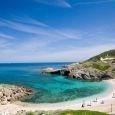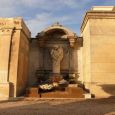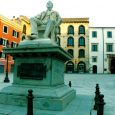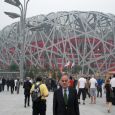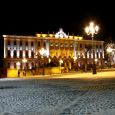Sassari
Advertisement
By Air
The nearest airport is Fertilia International Airport is 25 km from the city.In addition to residents of the province attracting large flows from other parts of the island and by offering flights of low cost airlines.The Chamber of Commerce of Sassari, Sassari province of Sassari and the same municipality are among the members of the management company, the Sogeaal.About 100 km away from the airport of Olbia-Costa Smeralda, while at Platamona 12 km from the city center is un'aviosuperficie used by fans of ultra-light aircraft.It was proposed that the creation of a third airport at Olbia, in the locality Muddizza poise, which has created controversy about the real infrastructure needs and the location near the site of Community importance of the mouth of the Coghinas.
By Train
Sassari is connected through the State Railways in Olbia, Cagliari (both with joint Ozieri - Chilivani) and Porto Torres.It is also linked to several neighboring municipalities through regional lines (Sardinian Railways).These railways, as all of Sardinia, are not electrified, and the entire fleet consists of railcars and locomotives powered thermal (diesel).The main links are Sassari-Alghero, Sassari-Nulvi, Sassari resource and are made of narrow-gauge tracks.At the main train station in Sassari is an active existing intermodal center that allows the movement of containers between rail and wheel.
By Ferry
The closest seaport is located at Porto Torres, 16 km from the town.With daily connections to port the port of Genoa and Corsica and other destinations in the south of France.Since March 2009, also is an active connection to the city of Barcelona.
By Bus
Urban and Suburban Public Transport is operated by 23 bus lines of Azienda Trasporti Pubblici (ATP) and by a light rail transit of Ferrovie della Sardegna (FdS).Two different railway companies connect the town to the rest of island, Trenitalia links Sassari to Porto Torres, Oristano, Cagliari, Olbia, Golfo Aranci, the FdS reach Alghero, Sorso, Nulvi and Palau.
St. Nicholas Cathedral
is the church's main city of Sassari.It is located in the historic center, Piazza del Duomo.Commonly called the Cathedral, the temple is the seat of the chair of Metropolitan Archbishop of Archdiocese of Sassari.Dedicated to St. Nicholas of Myra, the Cathedral is also a parish church in the city.The existence of a church dedicated to St. Nicholas in Sassari goes back to the twelfth century, being mentioned in a document monastery, the St Peter's Condaghe Silki, but in fact built on an existing building of the early Christian, whose remains are visible under the present apse.This church was rebuilt in the thirteenth century -style Romanesque - Pisa.
Usini Palace
The Palace is the ultimate expression Usini architectural Sassari.Carrera is located in the old Hanna (now Piazza Tola).It is one of the oldest houses in the city, now in use of library, the fact is Library Hall of Sassari.It belonged to Don Giacomo Manca, lord of Usini, and later Duke Asinara.In 1865 the building was purchased by the Town Hall for the purpose of adapting it to the Town Hall.Over the centuries the building has undergone many alterations, including, in the eighteenth century, the addition of a third floor.The windows all have the same shape, except for storage areas, which have a smaller size.
Rosello Fountain
is of historic architecture and Sassari, often identified as a symbol of the city is placed at the center of Valley Rosello, dominated by the bridge Rosello of the fascist period, and at the foot of the eponymous district of more Monte Rosello.The fountain through the allegorical meaning summarizes the flow of time, symbolized by the twelve mouths, and calls Cantaros the presence of four statues representing the seasons.In the early seventeenth century Fountain of the Rosello was a novelty in its forms and themes derived from the models the late- Renaissance , making it a unique monument in the whole Sardinia.To bring water from the houses Rosello was a host of water-carriers at the source to fill their barrels then loaded on the saddle of their asses.Around the end of the nineteenth century used donkeys to transport water came to be about three hundred.The fountain was used by housewives for doing laundry and linen garments.
Ducal Palace
is a historical building of Sassari realized in the second half of the eighteenth century.Today is the seat of local authority.The building was built in the period between 1775 and 1805 - by Lombard craftsmen direct Piedmontese architect Charles Valino - at the behest of Don Antonio Amat Manca, grandson of Diego which was the title of Marquis de Mores, and in 1775 was enfeoffed the island of Asinara and the title of Duke.However, he died a few months before seeing the completed building, so that was the first to settle his nephew, Don Vincent Amat Manca, Duke de Vallombrosa.After him it was inhabited by other individuals, then was occupied by the prefecture, following by the provincial and finally, in 1878, the Town Hall of Sassari, which hired him to municipal assets.
Ethnographic Museum Francis Bands
is located in the city of Sassari,named after Francesco Bande,diatonic accordion player known.The museum holds a collection of antique clothing and costumes from all parts of Sardinia, as well as a collection of ancient traditional instruments,the diatonic accordion, some of which belonged to the same bands.
Civic Theatre
is located in the heart of the city along Corso Vittorio Emanuele II.Area currently occupied by the Civic Theatre stood until 1826 the City Palace, overlooking the Piazza del Comune disappeared, midway through the de Codinas Plath, central axis of the walled city.The precarious conditions of the medieval, as the redevelopment of the early decades of the nineteenth century initiated by King Carlo Felice, led in 1826 to the decision to erect a new Town Hall structure with the shape of the neoclassical.Made on a project of the then city architect Joseph Cominotti, included an adequate community theater dedicated to replace the previous facilities on site, designed in a horseshoe on the example of the Teatro Carignano in Turin, although smaller.Between the two functions of the building, the privilege granted to the theatrical structure determines its inadequacy as a town hall, bringing the move first Usini Palace in 1879, and in 1900 the present location in the Palazzo Ducale.
The Sardinian Cavalcade
Since 1711, the year cited by Enrico Costa, the city also is the scene of the Sardinian Cavalcade, which since 1951 has been organized annually on the Sunday of Ascension Day (third Sunday of May).The event, a secular character, is the parade of folk groups from various areas of Sardinia which, on foot or on horseback and wearing their traditional costumes, show to the public and ethnographic aspects of Sardinian culture, food and wine.
National Museum archaeological and ethnographic GA Sanna
is the largest museum institution of Sardinia, north-central.It is named after Giovanni Antonio Sanna, businessman and politician born in Sassari.The structure is divided into three sections: archaeological, ethnographic, artistic.
January - April
September - December


